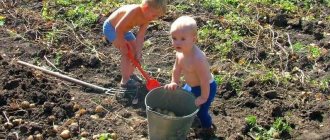Manual and artistic labor as a type of labor for preschool children
CONTENT
1. Introduction 2
2. Characteristics and importance of manual and artistic labor for the development of the personality of preschool children 3
3. Methodology for organizing and managing manual and artistic labor in different age groups 6
4. Conclusion 9
References 10
Labor is a purposeful human activity aimed at modifying and adapting natural objects to satisfy one’s needs.
K.D. attached great importance to labor education. Ushinsky - “Education should not only develop the mind, equip it with knowledge, but also ignite in a person a thirst for serious work...”
A.S. attached great importance to work. Makarenko, N.K. Krupskaya, V.A. Sukhomlinsky. Throughout the development of preschool education, much attention was paid to the problem of labor education of preschoolers:
- it was considered important and obligatory to introduce self-service work, work in the garden and in the garden, manual labor with various materials.
- the leading tasks were identified - to learn to work with joy; teach you to work efficiently.
Since 1964, systematic in-depth studies of the problem of labor education began: V.G. Nechaeva, G.N. Godina, D.V. Sergeeva, R.S. Bure, A.D. Shatova and others.
Their research answered the question about the content, means, methods and forms of labor organization and its role in educating the personality of a child of childhood.
The absence of a labor component in the educational process can lead to a delay in personal development.
Children's manual labor consists of independently making crafts using simple tools. This work, as a rule, has a practical, to a certain extent useful orientation. Children’s awareness of the expediency of their work activity has a significant impact on its quality, on the attitude of each child to the process and result of work. The individual nature of manual labor (meaning that even with collective work, each of the children performs some part of it with their own hands), provided that all children are consistently introduced to it, allows us to record and correct some shortcomings. Work becomes an effective means of education and personal development only when it is naturally included in the daily life of the kindergarten, is aimed at satisfying children’s interests, is feasible for the child,
Carrying out collective tasks develops in children the ability to negotiate with each other, subordinate their interests and desires to a common goal, fosters a sense of camaraderie, mutual assistance, responsibility, and develops initiative and ingenuity. In the process of performing collective tasks of a visual nature, children learn to independently plan the upcoming work, coordinate their actions with the general plan, think through the sequence of its implementation, select and use the necessary visual material. At the same time, in collective work, the individual characteristics of children are clearly revealed and creative abilities are formed.
Artistic labor is the work of a child with various materials in order to create useful and artistically and aesthetically significant objects and products to decorate his life, games, work and leisure. This child labor is a decorative, artistic and applied activity, since the child, when creating beautiful objects, takes into account the aesthetic qualities of materials based on his ideas, knowledge and practical experience acquired in the process of work. Properly organized manual and artistic work gives children knowledge about the quality and capabilities of materials, stimulates the desire to master the characteristics of craftsmanship, and introduces them to decorative and applied arts.
The formation of a child’s personality is impossible without labor education. In the senior and preparatory groups, the main role is played by manual labor with elements of creativity. The manifestation of creativity of preschoolers is determined by the nature of the implementation of the mental tasks offered to them. It is important that children can release their creative energy. In terms of practical significance, the basic skills acquired in handicraft classes are needed by every person. In these types of work, many important qualities are cultivated: the habit of effort, the ability to overcome obstacles, responsibility, the ability to plan work and anticipate the stages in the sequence of its implementation.
In particular, beadwork is a type of needlework that can be used to solve the following problems:
· instill interest in the culture of their homeland, in the origins of folk art, cultivate an aesthetic attitude to reality, hard work, accuracy, perseverance, patience, the ability to complete the work started, mutual assistance in carrying out work, an economical attitude to the materials used, instill the foundations of a work culture.
· develop motor skills, imaginative thinking, attention, imagination, creativity, and form aesthetic and artistic taste.
In the process of classes, children develop attention, observation, imagination, fantasy, and creativity. In every task, in every lesson, children are given the opportunity to imagine, and are encouraged to bring their own images into the work. Practical work on beadwork develops the eye and fine motor skills of the hands, which is an important element of general labor training.
In the process of engaging in artistic work, all mental processes are formed in children of senior preschool age, creative abilities and a positive emotional perception of the world around them develop. N.K. also attached great importance to classes in artistic manual labor in the comprehensive development of the individual, and especially in moral and aesthetic education. Krupskaya: “Classes in artistic manual labor should be gymnastics for the eyes and touch, establish the coordination of visual impressions and motor reactions, and provide a concrete acquaintance with the world of things.”
Learning through artistic and manual labor classes is impossible without the formation of such mental operations as analysis, comparison, and generalization. In the process of observation, when examining objects and their parts, the size and location of parts in an object, the color image of objects of different shapes, their comparison and establishment of differences. At the same time, children learn to compare objects and phenomena and highlight what is common and different in them, and combine objects by similarity.
In art classes, children's speech develops: mastering the names of shapes, colors and their shades, spatial designations that help enrich the vocabulary.
A child who can do a lot feels confident among his peers. It is also desirable in their games. In their little affairs. All this provides the child with a comfortable position among children and adults, and contributes to the manifestation and formation of such an important personal quality as independence. The child becomes more sensitive to the beauty in the surrounding life, in hand-made objects and people. The child begins to appreciate the results of the labor of not only his own, but also those of others.
Junior groups. It is necessary to arouse interest in “researching” the material and working with it, help to gain confidence in one’s own abilities, and enjoy the result of one’s work. It is necessary to encourage children to master spatial relationships between objects and certain physical laws, and to understand the properties of materials. To develop in children basic practical skills in working with materials and tools.
Middle group. There is already training in paper construction: bend a rectangular sheet of paper in half, aligning the sides and corners, and glue the parts to the main shape. You can teach how to make crafts from natural materials: bark, branches, leaves, cones, chestnuts, etc. The teacher teaches how to use glue and plasticine to secure parts; use reels, boxes of various sizes, plastic bottles, etc. in crafts.
Senior group. The ability to work with paper is improved: bend the sheet four times in different directions; work according to the finished pattern. Children learn to create three-dimensional shapes from paper: divide a square sheet into several equal parts, smooth out the folds, cut along the folds. Training continues in creating toys, souvenirs from natural materials (cones, branches, berries) and other materials (spools, colored wire, empty boxes), firmly connecting the parts. The ability to independently make toys for role-playing games is developed; souvenirs for parents and kindergarten staff; Christmas tree decorations. It is good to involve children in the production of manuals for classes and independent activities, repairing books, and printed board games.
Preparatory group for school. Here you can already divide the work of a teacher into several types:
Working with paper and cardboard - continue learning how to fold rectangular, square, round paper in different directions; use paper of different textures, make markings using a template; create fun toys; creating objects from strips of colored paper, selecting colors and their shades when making toys, souvenirs, costume parts and decorations for the holidays; developing the ability to use a sample; creating a variety of three-dimensional toys using the origami technique.
Working with fabric - learning how to thread a needle, tie a knot, sew on a button, a hanger, sew simple items with a needle-forward seam; teach how to make applique using pieces of fabric of various textures, apply an outline using chalk and cut out in accordance with the intended plot.
Working with natural materials - creating figures of people, animals, birds from acorns, pine cones, seeds, etc., conveying the expressiveness of the image, creating general compositions.
Conditions for independent creative activity of preschool children:
· a subject-development environment rich in iso-materials and a variety of materials for children’s artistic creativity;
· free access to materials and the opportunity to experiment with them;
· availability of samples of products and crafts;
· use of artistic products created by children to decorate a preschool institution, prepare attributes for performances, organize exhibitions, and participate in competitions;
· creation of a museum of children's crafts, albums, books;
· direct involvement of parents in the process of creative activity with children.
To successfully teach preschoolers manual and artistic work, it is necessary to carry out certain preliminary work:
· creation of exhibitions
· creation of collections (candy wrappers, buttons, shells, stones, etc.)
· creation of albums (samples and diagrams of crafts, types of fabrics, herbarium, etc.)
· experimentation
· viewing filmstrips
· reading literature
· looking at paintings
· excursions
· collages
Materials and tools necessary for manual and artistic labor in preschool educational institutions:
· natural material (spruce, pine, cedar cones, conifer needles, bark, leaves, fruit and berry seeds, eggshells, pebbles, cereals, vegetable and flower seeds)
· waste material (boxes and jars of different sizes, disks, lids, tubes, candy wrappers, etc.)
· paper (plain, corrugated paper, napkins, newspapers, cardboard, foil)
· fabric, wire, cotton wool, cellophane, beads, foam rubber, buttons, etc. d.
· scissors, glue, plasticine, brushes, sewing needles.
Manual and artistic labor - by its purpose, is labor aimed at satisfying the aesthetic needs of a person.
Its content includes the production of crafts from natural materials, paper, cardboard, fabric, wood. This work contributes to the development of imagination and creative abilities; develops small arm muscles, promotes endurance, perseverance, and the ability to finish what you start.
Children delight other people with the results of their work by creating gifts for them.
Artistic work in a preschool institution is presented in two directions: children make crafts and learn to decorate the group room for the holidays with their products, design exhibitions, etc.
Certain elements of manual and artistic labor can be introduced already in younger groups.
In this case, the participation of an adult is mandatory. More precisely, children help an adult in creating crafts. And although the activity of children of this age is minimal, involvement in such interesting work is very useful.
The child sees how, in the hands of the teacher, a simple stick suddenly turns into a doll, and a ball into the head of a funny clown. This “magic” fascinates children, delights them and motivates them to their own activities.
1. Bondarenko T. Introducing preschoolers to work. Methodical manual: - Method; 2014, 208 pp.
2. Bure R. Preschooler and work. Theory and methodology of labor education. A manual for teachers of preschool institutions: - Mosaic-Synthesis; 2011
3. Dmitriev Yu.A. Preparing students for labor education of preschool children // Teacher of the XXI century. No. 1, 2013, p. 104-109
4. Karpyuk G.A., Shabalin E.S. Educators on the organization of interaction with parents in the labor education of preschoolers // Preschooler. methodology and practice of education and training. No. 4, 2012, p. 54-56
5. Kutsakova L.V. Construction and manual labor in kindergarten. Program and methodological recommendations. For children 2-7 years old: - Sphere, 2011.
6. Saygusheva L. I. Technologies for introducing preschool children to work: Phoenix, 2013, 221 p.
7. Saygusheva L.I. Education of labor activity in children of senior preschool age: LAP LAMBERT, 2012, 219 p.
8. Semenova N. A. Possibilities for organizing research activities in the process of labor education of preschoolers // Kindergarten: theory and practice. No. 8, 2011, p. 70-75
9. Khlybova G.V. Labor education of preschool children (from work experience). Collection of proceedings of the conference “Education: traditions and innovations”. 2014, p. 450-452
MAGAZINE Preschooler.RF
Development of preschool children in different types of manual laborA.S. Gumberg, teacher of MAOU No. 50, Tomsk
The purpose of the Federal State Educational Standard of preschool education is to form the personality of pupils,
their cognitive abilities, creative potential, since society needs creative individuals capable of active self-realization [4, p. 1]. Positive changes in preschool education give freedom to the teacher in choosing the forms and methods of teaching preschool children.
Modern education is characterized by systemic changes in structure and content. Rethinking the priorities of education, the role of the child as a subject of the educational process, as well as social changes, determine non-traditional approaches to solving many educational problems. One of the leading trends in the development of modern education is the integration of its content. In the work activities of preschool children, all educational areas outlined in the Federal State Educational Standard for Education are optimally integrated.
One of the types of labor education is manual labor. In our opinion, it is this type of work that develops useful practical skills in children, creates an interest in work, the ability to evaluate one’s capabilities, and the desire to do the job as best as possible (stronger, more stable, more elegant, more accurate). In manual labor, children learn through experience elementary ideas about the properties of various materials: the material undergoes various transformations, various things can be made from it [1, p.13].
Manual labor is a form of child activity, during which an object product appears. At its core, manual labor, including construction from various types of materials, contributes to the comprehensive development of a child’s personality.
Manual labor in kindergarten is all kinds of educational activities recorded in the program for teaching preschool children. In the kindergarten program, manual labor includes working with a variety of materials: paper, natural materials, fabric. The production of toys and objects by children from various materials is one of the most important aspects of the labor education of preschool children, especially in older groups. This type of work opens up broad prospects for creation.
Today, there are quite a lot of works devoted to manual labor techniques in kindergarten. For example, the works of N.A. Vetlugina, G.G. Grigorieva, T.G. Kazakova, T.S. Komarova, N.P. Sakulina and others.
A. Marshall defines work as any mental and physical effort undertaken partially or wholly with the aim of achieving any result, not counting the satisfaction received directly from the work done itself [2, p. 785].
In the studies of K.I. Chukovsky, T.I. Ushakova, L.V. Kutsakova found that in the process of creative construction from various materials, children develop an idea of generalized methods of constructing activities, similar to those observed in children's writing. This allows us to consider manual labor not only as a means of creating specific objects, but also as an activity in the process of which a universal ability to build new wholes of various types of designs, plots, etc. is formed [5].
Conducted studies (T. S. Borisova, A. V. Brushlinsky, V. T. Kudryavtsev, A. V. Kushneruk, Zh. P. Labodaeva, A. N. Leontyev, N. N. Poddyakov and others) show that Thanks to manual labor classes, the child develops fine motor skills and improves his skills in working with various materials, devices and tools; Accuracy, independence, an original approach to solving problems, and the ability to freely navigate the world around them are developed.
Manual labor represents enormous potential and great opportunities for the development of creativity, fantasy and imagination. The child gets the opportunity to reflect his impressions of the world around him, convey images of his imagination, translating them into real forms using a variety of materials. Every child is a creator by nature. The child acquires his first ideas about aesthetics and aesthetic attitude to the surrounding world (nature, the objective world, works of fine art), and artistic experience in various types of manual labor. Thus, acquired ideas, experience, and abilities are the basis for creative activity [3].
One of the stages of work on the development of preschool children in the process of manual labor was the creation of a subject-development environment.
The children's creativity center “Do It With Your Hands” , is presented with a variety of materials for organized and independent manual labor activities.
When organizing the space, the division into “mini-workshops” : “The World of Unnecessary Things” , “Miracles from Paper” , “The Kingdom of Nature” , “Magic Threads” , etc. Albums and manuals have been collected: “New Year's crafts” , “Fun crafts for children” , “Gifts and Souvenirs” , “Craftswoman” , magazines “Country of Masters” , “Collection of Ideas” , card indexes of illustrations, photographs of crafts.
To improve the ability to freely experiment with various techniques and techniques, the center presents different types of materials:
- Paper. White and colored cardboard, watercolor paper, writing paper, paper napkins, double-sided paper, magazine paper, newsprint, tracing paper, corrugated paper, etc.
- Natural material. Plant seeds, tree bark, fruit and berry seeds, dry leaves, dried flowers, nuts, conifer needles, twigs, moss, feathers, pebbles, etc.
- Materials for weaving, knitting, sewing
- Cereals, curly pasta
- Waste material: boxes, spools of thread, plastic bottles, caps of various sizes and materials, disposable tableware, foam rubber, twine, cotton pads, cotton swabs, wire, foil, beads, discs, etc.
-Tools and materials necessary for work.
The subject-spatial environment, varied in content, contributed to the development of original ideas in children, aroused the desire to invent and apply creative discoveries in organized and independent activities.
To increase children's motivation for creativity, computer presentations “Secrets for little masters and craftswomen” .
In the process of manual labor, students became familiar with the properties of various materials and methods of working with them. The use of a variety of techniques and techniques made it possible to expand the range of children’s work and brought many positive emotions. Children, fascinated by the unusual way of creating images, independently found original ways to convey images.
Hard work and the ability to work are not given by nature, but are cultivated from early childhood. By accustoming children from an early age to the simplest types of work available to them, independence and the desire to provide all possible assistance to adults are formed; in work, children master a variety of skills and abilities necessary in everyday life.
Thus, there is every reason to consider manual labor as an important element of meaningful upbringing of children. Manual labor provides children with the opportunity to put into practice basic knowledge from the field of drawing, appliqué, design, and also use the experience of their own life observations. By doing manual labor in kindergarten, children not only develop a certain apparatus of actions, knowledge and skills, but also increase their development potential. The child becomes more self-confident, and therefore free to choose goals and find ways to achieve them.
Bibliography
- Balandina, E. A. Mastery of labor activity by preschoolers: forms of work, practical experience, notes on educational activities / E. A. Balandina, I. G. Istomina, E. V. Zagorskaya. – Volgograd: Teacher, 2014. – 95 p.
- Mayboroda, N. A. Manual labor in kindergarten / N. A. Mayboroda. — Text: immediate // Young scientist. - 2014. - No. 2 - P. 785 - 787. - URL: moluch. ru (date of access: 10.05.2020).
- Makhaneva, M.D. We teach children how to work. Allowance / M.D. Makhaneva. – Moscow: Sphere shopping center 2012. – 264 p.
- Order of the Ministry of Education and Science of the Russian Federation dated October 17, 2013 No. 1155 “On approval of the Federal State Educational Standard for Preschool Education . - Moscow 2013.
- Rumyantseva, E.A. We make toys ourselves / E.A. Rumyantseva. – Moscow: Iris-press, 2014. – 192 p.
| Next > |
What is manual labor in kindergarten
Oksana Vlasenko
What is manual labor in kindergarten
What is manual labor in kindergarten? Is it needed?
Manual labor
- this is a child’s creative work with various materials, during which he creates useful and aesthetically significant objects and products for decorating everyday life (games, work and leisure).
is an essential component of the development of a child’s basic and creative abilities,
the most important means of mental, artistic and aesthetic development and moral education.
Conditions for successful organization of manual labor
— Saturated with fine art materials and a variety of materials for artistic creativity, a subject-development environment;
- free access to materials and the opportunity
experimenting with them;
- use of artistic products created by children to decorate a preschool institution, organize exhibitions, participate in competitions, create a museum of children's crafts;
— direct involvement of parents in the process of creative activity with children
CONTENT OF MANUAL WORK FOR PRESCHOOL CHILDREN
— Working with fabric and threads
— Working with natural materials
— Working with paper, cardboard
— Working with waste and artificial materials
— Working with dough, clay
In my work I use such types of work as: modeling, designing from paper (origami, making crafts from natural materials, dough, plasticine, decorative clay, waste material.
Children really enjoy doing these types of work, as they give the child the opportunity to experiment and creatively think through their intended product.
And as V. A. Sukhomlinsky said: “The more skill in a child’s hand, the smarter the child”
V. A. Sukhomlinsky emphasized:
“Manual labor contributes to the diversified development of a child’s personality.
Artistic and creative activities distract children from sad events, relieve nervous tension and fear, and provide a positive emotional state. Therefore, it is so important to include artistic manual labor in the pedagogical process of kindergarten.”
Manual labor develops in children:
— Develops speech
– Increases sensory sensitivity
— Develops imagination, spatial and logical thinking
- Manual dexterity, fine motor skills, eye
— Coordinates the work of the eyes and hands (sensorimotor)
— Forms the ability to plan work
— Develops strong-willed qualities (perseverance, patience, ability to finish a job)
— Promotes the development of artistic abilities and aesthetic taste.






